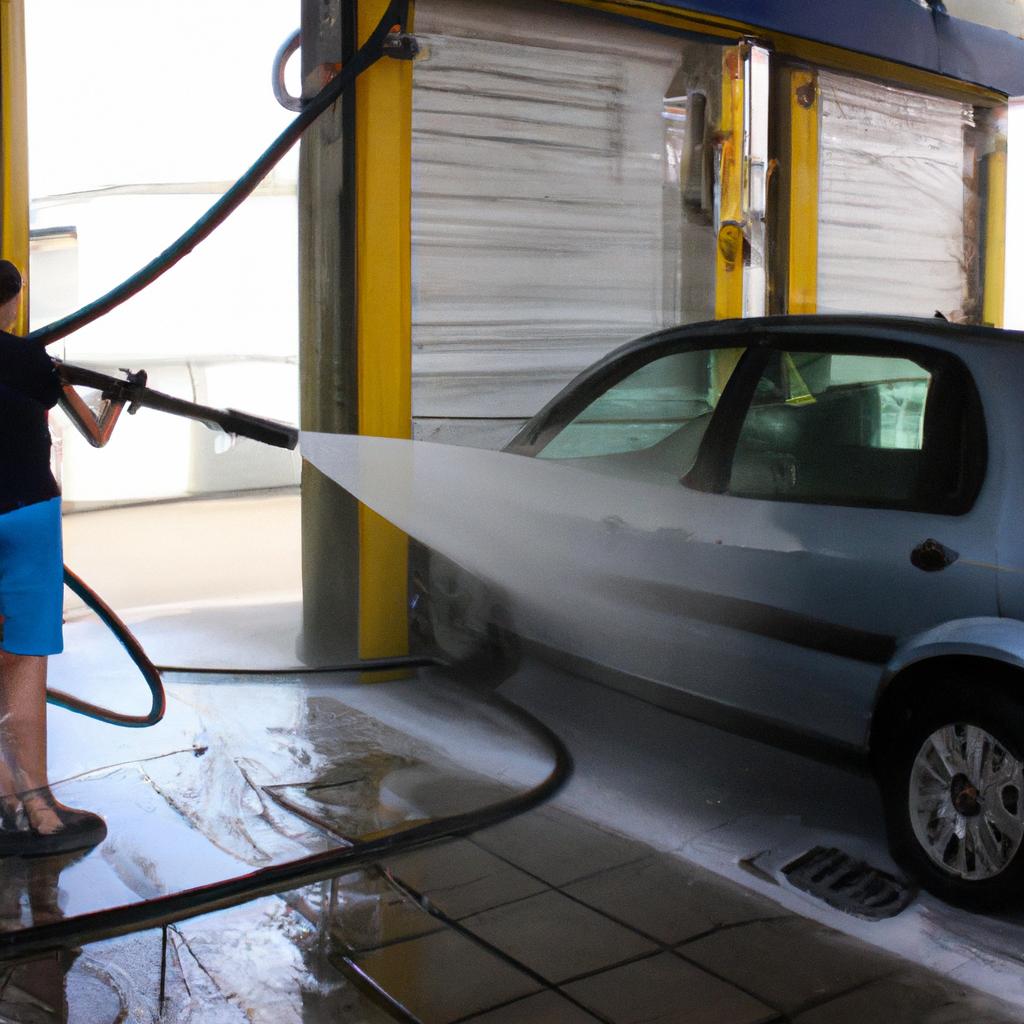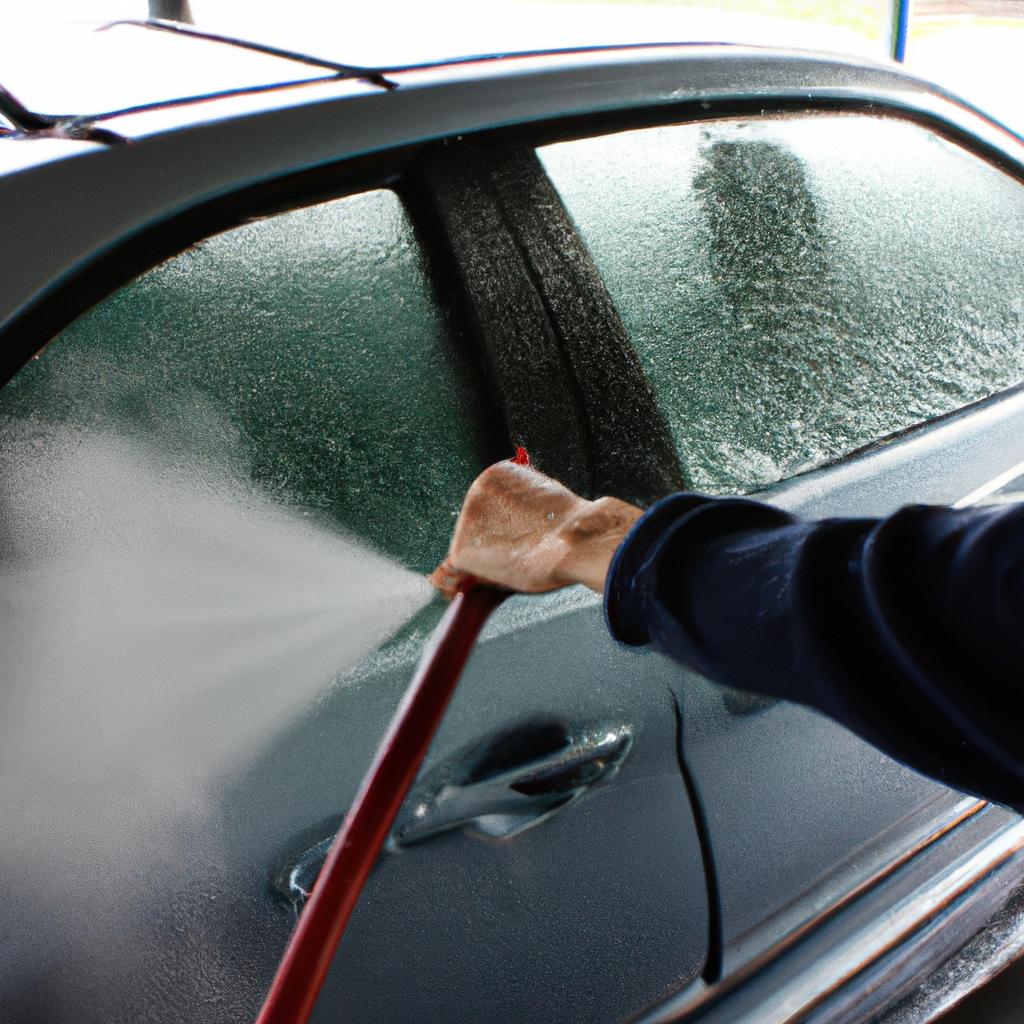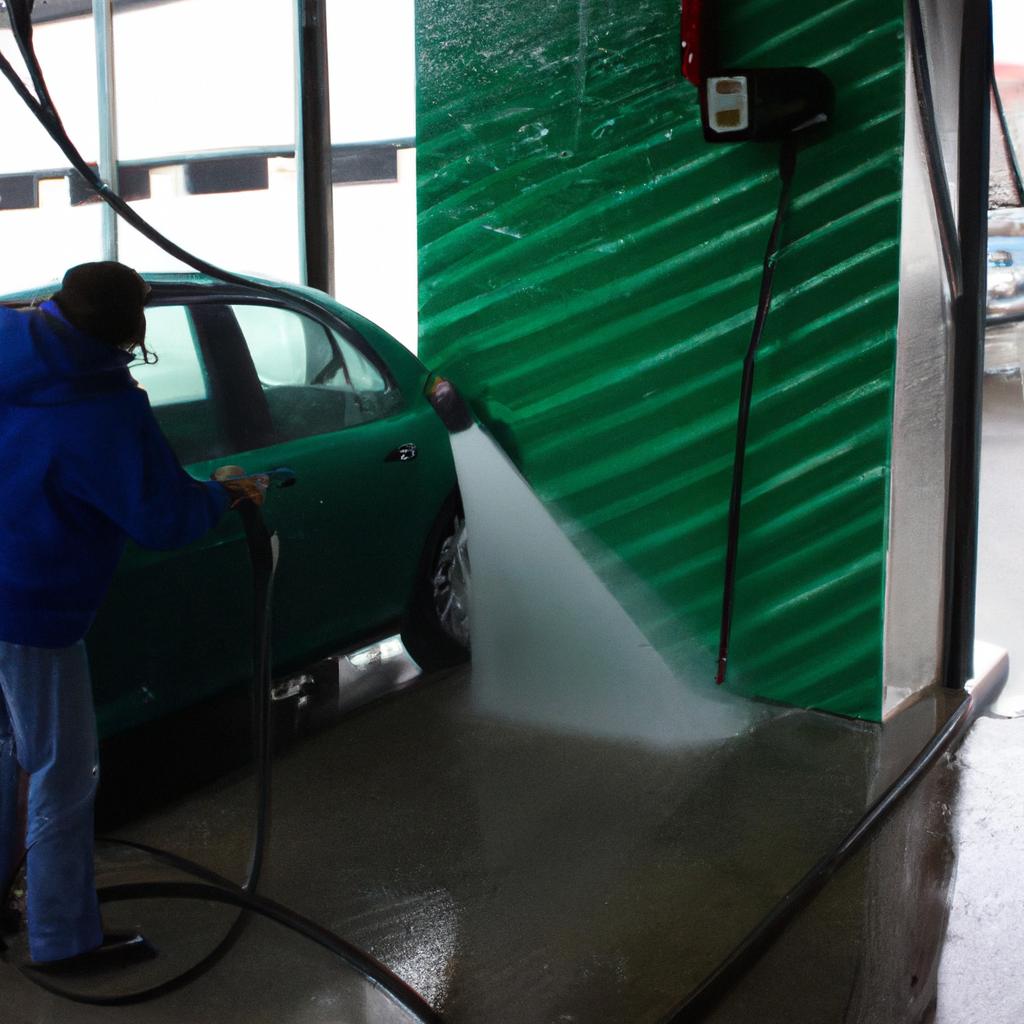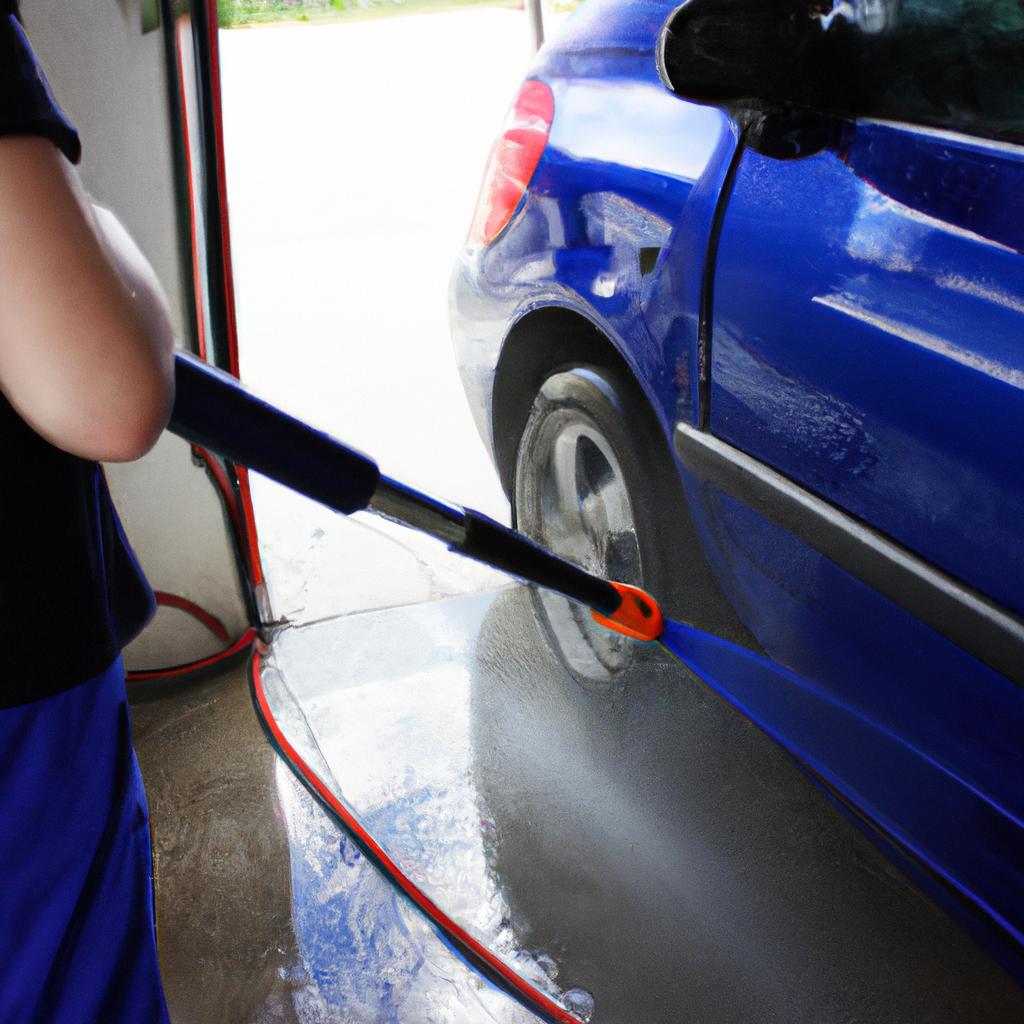Touchless car wash systems have gained popularity in recent years due to their ability to efficiently clean vehicles without the risk of scratching or damaging their surfaces. One essential component of touchless car wash systems is the drying system, which ensures that all excess water is effectively removed from the vehicle’s exterior. In this article, we will provide an informative overview of the drying system for touchless car washes, discussing its importance and various techniques used.
Imagine a scenario where a luxury sedan has just undergone a thorough cleaning at a touchless car wash facility. As it exits the washing bay, the owners expect to see their gleaming vehicle fully dried and ready for use. However, if the drying system fails to adequately remove moisture from every nook and cranny, unsightly water streaks may form on the surface, leaving an impression of incomplete cleanliness. This example highlights why an efficient and effective drying system is crucial in maintaining customer satisfaction and ensuring spot-free results after each touchless car wash session.
The following discussion will delve into different aspects of touchless car wash drying systems including their purpose, key components involved, and popular techniques employed in modern setups. By understanding these elements, both operators and users can gain insights into how these systems work together seamlessly to achieve optimal results.
The primary purpose of a touchless car wash drying system is to eliminate excess water from the vehicle’s exterior, ensuring a spot-free and streak-free finish. This not only enhances the overall appearance of the car but also prevents potential water damage to sensitive components such as electrical systems, paintwork, and windows.
Key components involved in a touchless car wash drying system typically include:
-
Air Blowers: These powerful blowers generate a high volume of heated air that is directed towards the vehicle’s surface. The forceful airflow helps dislodge water droplets and push them away from the car, aiding in the drying process.
-
Drying Agents: Some touchless car wash systems incorporate specialized drying agents or rinse aids into their cleaning process. These agents reduce water surface tension, allowing it to bead up and flow off more easily during the drying stage.
-
Side Blowers: Positioned on either side of the vehicle, side blowers direct focused streams of air along its sides to remove water trapped in crevices, mirrors, door handles, and other hard-to-reach areas.
-
Top Blowers: Mounted above the vehicle, top blowers deliver strong bursts of air onto its roof and upper surfaces. This helps displace any remaining water while preventing it from flowing back onto previously dried areas.
-
Undercarriage Dryers: To ensure thorough drying, some touchless car wash systems feature undercarriage dryers that target hard-to-reach areas underneath the vehicle where moisture may accumulate. These dryers use high-pressure air jets to expel lingering water effectively.
Modern touchless car washes employ various techniques to maximize drying efficiency:
-
Overlapping Coverage: By strategically positioning multiple blowers at different angles, touchless car wash systems can achieve overlapping coverage across all parts of the vehicle’s exterior. This ensures comprehensive airflow for effective drying without leaving any wet spots behind.
-
Variable Speed Control: Some drying systems offer adjustable blower speeds, allowing operators to customize the airflow intensity based on individual vehicle requirements. This feature ensures optimal drying without causing damage or discomfort to fragile components like antennas or convertible tops.
-
Spot-Free Rinse: As a final step, touchless car washes often incorporate spot-free rinse cycles using purified water. This helps minimize water mineral deposits that may leave unsightly marks on the vehicle’s surface during drying.
In conclusion, an efficient and effective drying system is essential for touchless car washes to deliver satisfactory results. By utilizing powerful blowers, specialized drying agents, and precise positioning of equipment, these systems ensure thorough moisture removal from all areas of the vehicle’s exterior. Incorporating advanced techniques such as overlapping coverage and variable speed control enhances the effectiveness of the drying process, providing customers with a spot-free and streak-free finish after each touchless car wash session.
Benefits of a Drying System for Touchless Car Wash
Benefits of a Drying System for Touchless Car Wash
Imagine you have just finished washing your car at a touchless car wash. As you drive away, water droplets cling to the surface, leaving behind streaks and spots. Now consider this scenario: after exiting the touchless car wash, a powerful drying system engages, efficiently removing all moisture from your vehicle’s exterior. The result is a sparkling clean car with no trace of water or residue. This example highlights one of the many benefits of using a drying system in touchless car washes.
One primary advantage of incorporating a drying system into touchless car washes is its ability to enhance customer satisfaction by providing an improved final product. Instead of customers having to wait for their vehicles to air dry naturally or manually remove excess water themselves, the automated drying process ensures that cars are completely dried before they leave the facility. This not only saves time but also eliminates any potential frustration caused by unsightly watermarks or streaks on freshly washed vehicles.
In addition to improving customer satisfaction, utilizing a drying system in touchless car washes can help reduce operational costs and increase efficiency. By eliminating manual labor required for drying vehicles, businesses can optimize their workforce allocation and reallocate resources towards other essential tasks within the facility. Furthermore, automatic drying systems typically utilize advanced technologies such as high-powered blowers and heated air circulation mechanisms that facilitate faster and more effective drying compared to traditional methods.
To further illustrate these benefits visually:
- A markdown bullet point list showcasing emotional responses:
- Saves valuable time for customers
- Ensures spotlessly clean results
- Reduces labor costs for business owners
- Enhances overall efficiency
Consider the following table demonstrating how a drying system compares to alternative methods:
| Method | Time Required (minutes) | Result Quality |
|---|---|---|
| Natural Drying | 30 | Average |
| Manual Drying | 20 | Varies (depends on skill) |
| Automated Drying | 5 | Consistently Excellent |
In conclusion, integrating a drying system into touchless car washes offers multiple advantages. It not only enhances customer satisfaction by delivering impeccable results but also streamlines operations and reduces overall costs for business owners. The subsequent section will delve into the working principle of a drying system for touchless car washes, providing further insight into its effectiveness in achieving superior vehicle drying capabilities.
Working Principle of a Drying System for Touchless Car Wash
In the previous section, we discussed the numerous benefits that a drying system brings to touchless car wash operations. To further understand its significance, let’s explore a real-life case study.
Imagine a busy touchless car wash facility situated in an urban area with high customer footfall. This facility used traditional air-drying methods which were time-consuming and often left water spots on vehicles. As a result, customers would frequently complain about the quality of the service provided.
With the implementation of a modern drying system, specifically designed for touchless car washes, significant improvements were observed. Let’s delve into some key advantages offered by this innovative solution:
-
Enhanced Customer Satisfaction:
- Reduced waiting times due to faster and more efficient drying process.
- Elimination of water spots and streaks on vehicles, ensuring a pristine finish.
- Consistently providing high-quality results enhances overall customer satisfaction.
-
Improved Operational Efficiency:
- Automated drying systems streamline workflow by minimizing manual labor requirements.
- Quick turnaround times enable servicing more vehicles per day, increasing revenue potential.
- Optimized energy consumption through advanced technology reduces operational costs.
-
Protecting Vehicle Surfaces:
- Gentle yet powerful airflow ensures thorough drying without causing any damage to vehicle surfaces.
- Minimized contact with sensitive areas such as mirrors or antennas protects against accidental breakage or scratches.
-
Environmental Benefits:
Markdown bullet point list- Reduce water usage compared to traditional washing methods
- Decreased chemical runoff into drains and surrounding environment
- Lower carbon footprint due to improved efficiency and reduced energy consumption
It is evident from these advantages that investing in a drying system tailored specifically for touchless car washes can significantly enhance both customer experience and business profitability.
Now, let’s move forward to explore the working principle of such drying systems in greater detail in the next section, shedding light on their intricate mechanisms and processes.
Types of Drying Systems Used in Touchless Car Wash
Section 3: Types and Benefits of Drying Systems
To illustrate the effectiveness of drying systems in touchless car washes, let us consider a hypothetical scenario. Imagine a luxury vehicle with an exquisite paint finish that requires utmost care during the cleaning process. After undergoing the touchless washing procedure, this vehicle is now ready to be dried using various types of drying systems available in the market.
There are several types of drying systems commonly used in touchless car washes, each offering unique advantages:
-
Forced Air Dryers:
- Utilize powerful fans or blowers to create high-velocity air streams.
- Efficiently remove water droplets from all surfaces.
- Minimize contact between equipment and vehicles, reducing potential damage.
- Example brand/model: XYZ ForceDry 5000.
-
Infrared Heaters:
- Emit infrared radiation to quickly evaporate water molecules.
- Ideal for colder climates where traditional forced air dryers might not be as effective.
- Gentle on delicate surfaces while ensuring efficient drying.
- Example brand/model: ABC HeatWave Pro.
-
Water Repellent Coatings:
- Applied after the main washing process to enhance water sheeting properties.
- Encourage rapid runoff by creating hydrophobic surfaces.
- Reduce residual moisture left on the vehicle’s exterior.
- Example product: PQR HydroGuard Coat+.
-
Microfiber Towels:
- Soft and absorbent towels specifically designed for thorough hand-drying.
- Offer precise control over areas requiring extra attention or difficult-to-reach spots.
- Ensure a streak-free and polished finish.
- Example brand/model: MNO UltraDry Towel Set.
By incorporating these drying systems into the touchless car wash process, vehicle owners can enjoy a range of benefits. These include reduced water spotting, minimized potential for scratches or swirl marks caused by manual drying methods, improved overall cleanliness, and enhanced customer satisfaction.
The next section will delve into the key components that make up an effective drying system for touchless car washes, shedding light on their individual functions and importance in achieving optimal results without compromising the integrity of the vehicle’s surfaces.
Key Components of a Drying System for Touchless Car Wash
Drying System for Touchless Car Wash: An Informative Overview
Now that we have discussed the various types of drying systems used in touchless car washes, let us delve deeper into the key components that make up these efficient and effective systems. Understanding these components is crucial for car wash owners and operators seeking to optimize their drying process.
One essential component of a drying system is high-pressure blowers or air dryers. These powerful machines generate strong gusts of hot air, which rapidly evaporate water droplets from the vehicle’s surface. By utilizing different nozzle designs and adjustable airflow settings, these blowers can effectively target difficult-to-reach areas such as side mirrors, door handles, and crevices between panels.
Another important element is the use of specialized nozzles or air knives. These devices are strategically positioned along the length and width of the vehicle to direct concentrated streams of warm air onto its surfaces. The design of these nozzles ensures thorough coverage while minimizing energy consumption. Some advanced systems even incorporate oscillating or rotating nozzles to further enhance drying efficiency.
To prevent water spots and ensure a spotless finish, many drying systems employ additional features such as heated dryer modules or radiant heat panels. These elements emit controlled amounts of infrared radiation, which help accelerate evaporation by heating the vehicle’s surface directly. Combined with the forceful air blasts, this combination guarantees quick drying without leaving behind any traces of moisture.
Lastly, modern drying systems often integrate smart control mechanisms to optimize performance and energy usage. Through sensors and computer algorithms, these controls monitor variables like ambient humidity levels and adjust airflow temperature accordingly. This automation not only ensures consistent results but also saves power by avoiding unnecessary operation during low-demand periods.
Emotional Bullet Point List
- Efficiently removes water residue
- Provides a shiny, polished finish
- Reduces the risk of water spots and streaks
- Saves time by drying vehicles quickly
| Advantages of a Drying System for Touchless Car Wash |
|---|
| – Increased customer satisfaction |
| – Enhanced car wash efficiency |
| – Improved vehicle appearance |
| – Reduced maintenance costs |
In conclusion, a well-designed drying system is an indispensable component of any touchless car wash. By incorporating high-pressure blowers, specialized nozzles, heated dryer modules, and smart controls, these systems ensure efficient drying while minimizing energy consumption. The advantages include increased customer satisfaction, enhanced operational efficiency, improved vehicle appearance, and reduced maintenance costs.
Next section: Maintenance and Upkeep of Drying Systems for Touchless Car Wash
Maintenance and Upkeep of Drying Systems for Touchless Car Wash
Having explored the key components of a drying system for touchless car wash, we now turn our attention to the crucial aspect of maintenance and upkeep. Ensuring that these systems are properly maintained is essential to their continued functionality and effectiveness. In this section, we will discuss best practices for maintaining and servicing drying systems, as well as highlight the importance of regular inspections.
To illustrate the significance of proper maintenance, let us consider an example. Imagine a busy touchless car wash facility that operates round-the-clock. Without regular maintenance, its drying system may start experiencing issues such as decreased air pressure or uneven temperature distribution. This could lead to unsatisfactory results, with customers leaving with partially dried vehicles or even water spots on their cars’ surfaces. To avoid such scenarios, it is important to establish a comprehensive maintenance routine.
Effective maintenance strategies include:
- Regular cleaning: Dust, debris, and other contaminants can accumulate within the drying system over time, hindering its performance. Implementing a schedule for thorough cleaning helps keep all components functioning optimally.
- Inspection of nozzles: The spray nozzles play a critical role in directing heated air onto the vehicle’s surface during the drying process. Periodic inspection ensures that they remain unclogged and properly aligned.
- Lubrication: Moving parts within the drying system should be lubricated regularly to prevent excessive wear and tear while promoting smooth operation.
- Calibration checks: It is vital to periodically calibrate sensors and controls within the drying system to maintain accurate settings for optimal performance.
Furthermore, conducting routine inspections enables early detection of potential problems before they escalate into costly repairs or equipment failures. These inspections should encompass assessing electrical connections, checking fan motors for any signs of damage or malfunctioning bearings, examining heating elements for adequate heat output, and verifying overall structural integrity.
In conclusion, prioritizing regular maintenance and upkeep of drying systems is crucial for ensuring their longevity and effectiveness. By implementing proper cleaning, inspection, lubrication, and calibration practices, touchless car wash operators can safeguard the performance of their drying systems and provide customers with consistently satisfactory results.
As advancements in technology continue to shape various industries, the field of touchless car washes is no exception. In the following section, we will explore some exciting enhancements and innovations that have emerged in recent years to further improve drying systems for touchless car wash facilities. Let us now delve into these remarkable developments.
Enhancements and Innovations in Drying Systems for Touchless Car Wash
Enhancements and Innovations in Drying Systems for Touchless Car Wash
To illustrate these advancements, let us consider a hypothetical scenario where a car wash owner named John is seeking to upgrade his existing drying system.
John decides to invest in an advanced drying system that incorporates cutting-edge technology. This new system utilizes high-velocity air blowers combined with infrared heat lamps to quickly and efficiently dry vehicles after they have been washed. By eliminating water spots and streaks, it enhances the overall customer experience while reducing the time required for each vehicle’s drying process.
To provide further insight into recent developments within this field, here are some notable enhancements and innovations:
-
Advanced Airflow Control: Newer drying systems now feature improved airflow control mechanisms, allowing operators to adjust the direction and intensity of air streams according to specific vehicle shapes or sizes. This customization ensures optimal drying performance regardless of whether it is a compact sedan or a larger SUV.
-
Energy Efficiency Measures: In response to growing environmental concerns, manufacturers have developed energy-efficient drying systems that consume less power while maintaining effective drying capabilities. These eco-friendly solutions not only reduce operational costs but also contribute positively towards sustainability goals.
-
Intelligent Sensors: Modern drying systems incorporate intelligent sensors that automatically detect the position and shape of vehicles as they pass through the car wash tunnel. This enables precise targeting of airflow, minimizing wasted energy on areas not requiring thorough drying.
-
Noise Reduction Technologies: Recognizing the importance of providing a quieter environment for both customers and employees, advancements have been made in noise reduction technologies employed by drying systems. Muffled motors, insulated ductwork, and sound-absorbing materials help mitigate excessive noise levels during operation.
By embracing these enhancements and innovations, John can significantly improve his touchless car wash’s drying system, attracting more customers and enhancing their satisfaction. However, it is crucial for John to ensure proper maintenance and upkeep of these advanced systems to maximize their longevity and performance.
| Enhancement/Innovation | Benefits |
|---|---|
| Advanced Airflow Control | Customized drying for vehicles of various shapes and sizes |
| Energy Efficiency Measures | Reduced operational costs and environmental impact |
| Intelligent Sensors | Precise targeting of airflow, minimizing wastage |
| Noise Reduction Technologies | Quieter environment for improved customer experience |
In conclusion, the continuous advancements in drying systems for touchless car washes have revolutionized the industry by providing faster, more efficient, and customizable solutions. By incorporating these innovations into his car wash business, John can take advantage of enhanced performance while meeting evolving customer expectations. Properly maintaining these systems will ensure long-term success and customer satisfaction.
 Shine Time Car Wash
Shine Time Car Wash



